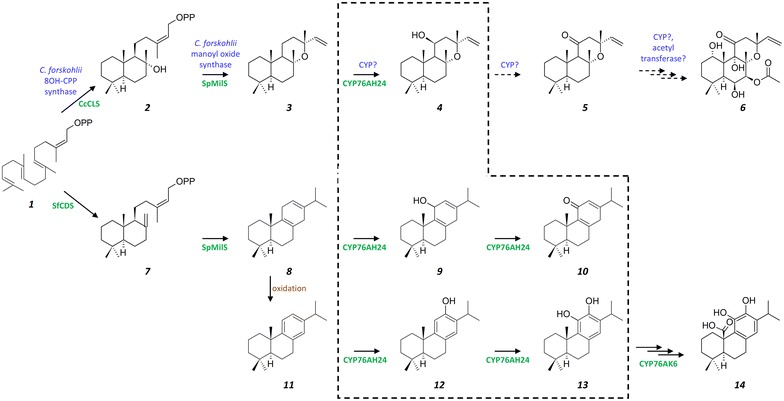Fig. 2.

Proposed biosynthetic pathway of forskolin and carnosic acid. Both pathways begin from the common diterpene precursor GGPP (1). In C. forskohlii, a class II diTPS converts GGPP to 8OH-CPP (2), which is then taken up by a class I enzyme, to form manoyl oxide (3). This, in turn, becomes oxidized at several positions (C-1, C-6, C-7, C-11), presumably by the action of specific CYPs, and eventually O-acetylated at the C-7 hydroxy to generate forskolin (6). 11β-hydroxy-manoyl oxide (4) and 11-oxo-manoyl oxide (5) are believed to be the first steps in this mechanism, although the enzyme(s) catalyzing these reactions in C. forskohlii have not yet been identified. In S. pomifera, GGPP is converted to CPP (7) and then to miltiradiene (8) by corresponding class II (CPP synthase; CDS) and class I (Miltiradiene synthase; SpMilS) diTPSs. Miltiradiene is non-enzymatically converted to abietatriene (11), the substrate of CYP76AH24. CYP76AH24 catalyzes two successive oxidation events, one on C-12 of abietatriene producing ferruginol (12), and a second one on C-11 of ferruginol producing 11-hydroxy-ferruginol (13). When provided with miltiradiene, in vitro or in yeast cells, CYP76AH24 catalyzes a two step oxidation leading to 11-keto-miltiradiene (10), via 11-hydroxy-miltiradiene (9) [26]. The dashed box encloses the reactions catalyzed by CYP76AH24. CYP76AK6 takes up 11-hydroxy-ferruginol to catalyze a three step oxidation leading to carnosic acid (14) [26]. The promiscuous class I diTPSs, SpMilS, can also accept 8OH-CPP (2) to produce manoyl oxide (3) [25] To reconstruct the first steps of the forskolin biosynthetic pathway in yeast, CcCLS was used to produce 8OH-CPP, SpMilS was employed to convert 8OH-CPP to manoyl oxide, and CYP76AH24 was exploited to oxidize manoyl oxide (3) to 11β-hydroxy-manoyl oxide (4)
